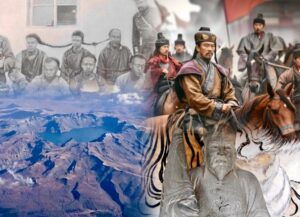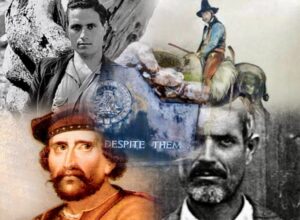Maciek Tarasin organized three expeditions to Chiribiquete, one of the most isolated places on the planet; a lost world of table mountains and dense jungle. In a 3-part series, the expedition team recount their journey to the legendary “Sistine Chapel” of the Amazon.
Each of Maciek’s expeditions to Chiribiquete had a single goal: to reach the regions flat mountain sides, where thousands of years ago, ancient Indian shamans had inscribed their mythology.
The first journey was unexpectedly foiled by FARC activity (Revolutionary Armed Forces of Colombia). During the second expedition Maciek was bitten by a fer-de-lance, a species of highly venomous pit-viper. The third set out at the start of November 2017.
Chiribiquete, FARC and a return to Colombia
“Half of Colombia is covered by the Amazon jungle, the paradox of which is that most Colombian people know nothing about it”, so said Ciro Guerra, the director of the film ‘Embrace of the Serpent’. One of the main characters in the film is Richard Evans Schultes, an ethnobotanist from Harvard University, and a close collaborator with the Swiss chemist and LSD inventor, Albert Hofman. In 1943, the same year in which Hofman embarks on his first acid trip in his Swiss laboratory, Schultes hacks his way through the pristine Colombian jungle. He has been sent by the American government on a mission to find rubber, a much needed resource during wartime. However, Schultes, having devoted his life to researching the medicinal and hallucinogenic properties of plants, had already developed a different fascination.
Schultes had heard about the table-flat mountains rising out of the heart of Chiribiquete, today a national park the size of Belgium. For thousands of years, on these mountain walls, unknown shamans painted what has been dubbed the “Sistine Chapel of the Amazon Jungle”. While working on their masterpiece the shamans must have been on such a high flying trip that Hofman’s acid experiments could be described as pedestrian in comparison.
Chiribiquete is the largest archaeological complex of rock murals in the northern part of South America. The paintings show intense scenes, such as hunting and ritual dances, as well as human and animal figures. Their dating is the subject of an ongoing debate, with some estimates putting them at up to 20,000 years old.
Rio Ajaju, November 2017
The team spilled out of the tiny plane at the airport in La Macarena. The little town boasts just a smattering of dirt roads and a few cheap bars, beckoning in their patrons with music and billiards.
It takes less than an hour by plane to get from chilly Bogota, situated as it is at an altitude of 2,600 meters, to the edge of the equatorial jungle. For the next three weeks they were to be self-sufficient, beyond this last Indian village there is only tropical forest crisscrossed by rivers. To get from Jaguara, the starting point for their journey, to the former penal colony of Aracuara, you must travel about 700km by water, and cut through a few dozen kilometers of virgin jungle. A tough task in and of itself. Within their drybags the team carried ultralight Polish Pinpack rafts, paddles, packets of dried beef, energy bars, hammocks complete with mosquito nets, cameras, GPS equipment, satellite telephones and spare batteries.
Giant anteaters scampered away at the sight of their speeding Toyota Hilux. A sandy red path snaked through the low, sun-dried grass. Eight hours passed before the car pulled up at an abandoned looking wooden cottage. There was only one inhabited hut in this spacious forest clearing. Three children peeked out of it timidly.
“They haven’t grown that much” the three Poles agreed. For Maciek Tarasin, Michał Dzikowski and Dominik Szczepański, Jaguara had been the starting point for their expedition three years ago. Their Irish companion, Shane Young, was here for the first time. It was here that the three Poles had listened to the story of an old man claiming to be the last jaguar hunter. A few dozen years ago he had belonged to a team of hunters devoted to satisfying the whims of rich people who wanted to decorate their apartments with the skin of the animal considered to be the most important by traditional shamans here. The jaguar is the guardian of the jungle, and a symbol of sexual potency to boot.
An Indian woman emerged from the shadows of the hut. She had acquired a few white hairs but her shy smile remained unchanged. Just as 3 years prior, she slaughtered one of her chickens, boiled some broth and served the meat with a mountain of rice and fried plantains.
On 30th November they launched their rafts onto the Rio Tunia, a river the color of milky coffee. It was three hours of paddling before they spotted an old man walking along the river bank.
“Good morning. Are things quiet on the river?” Maciek asked, recalling what had happened the last time he was there.
“Quiet” the skinny local, named David, replied. His shirt had a few buttons missing, but it did not make any real difference, he wore it unbuttoned all the way down. It was still a long way till noon, but the temperature had already crept up over 30oC.
“Three years ago we were stopped by the guerrillas” Maciek continued.
“FARC?” asked David, and without pausing for a reply he continued, “Yes, a few scouts were on the river”. Their presence did not seem to have made much of an impression on him. On the outskirts of Chiribiquete Indians have rubbed shoulders with the guerrillas for years. The peace treaty signed in 2016, after a 52-year civil war, has not yet extended through all of the region. Not all the guerrillas had relinquished their weapons and given up the dangerous, but profitable, cocaine production.
When they initially formed, FARC had hailed themselves as the protectors of the peasants, opposing the monopolization of natural resources by corporations from various countries. Only a few years ago FARC still controlled almost half of Colombia, and its 40-thousand strong army terrorized villages, kidnapping people, demanding ransoms and extorting protection money. The group’s primary source of income was the cocaine business, managed by its big boss, Pablo Escobar. It was a lucrative trade, and by the beginning of the 90s his assets were said to exceed 30 billion dollars. Meanwhile the Civil war in Colombia became the longest running conflict in the history of South America. An estimated 250 thousand people lost their lives and up to a further 60 thousand went missing.
The guerrillas were not a group they wished to run into again. They needed a way to evade the thugs cruising the Rio Tuni, and David turned out to be invaluable in implementing a plan. For the next two days he provided guidance to the four explorers, leading them through the jungle surrounding the Rio Ajaju, another river which winds its way along the rocks still adorned with ancient Indian paintings.
The expedition had accomplished the very first stage of their journey, and with valuable local help they hoped to avoid any confrontations with the remaining FARC fighters in the area. The teams next destination was the Rio Ajaju, where they would once again unpack their rafts and try to make some headway towards the paintings of Chiribiquete. Join us next week for part two in the series, where the team looks back at their two previous expeditions in 2014 and 2015, featuring FARC standoffs and deadly snakes.
Previous / Links:
The River of Traps: A Survival Story
Amazon Explorer Rescued After Pit-Viper Bite
Paddling Descent of Colombia’s San Jorge






